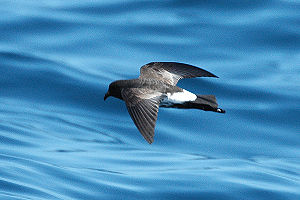New Zealand petrel
| New Zealand petrel | ||||||||||
|---|---|---|---|---|---|---|---|---|---|---|

New Zealand petrel ( Fregetta maoriana ) |
||||||||||
| Systematics | ||||||||||
|
||||||||||
| Scientific name | ||||||||||
| Fregetta maoriana | ||||||||||
| ( Mathews , 1912) |
The New Zealand petrel ( Fregetta maoriana , synonym : Oceanites maorianus ), also called Maori petrel , is a very rare New Zealand petrel . The IUCN classifies it as critically endangered . The current population is estimated to be fewer than fifty sexually mature individuals.
Features and distribution
The New Zealand petrel reaches a body length of 17 centimeters. The head is remarkably large in relation to the body size, the legs are long, the feet are relatively large. In flight, the feet protrude well beyond the tail, which ends in a straight line. The head, the neck and the top of the body are also black-brown, the white rump and the white upper tail-covers are strikingly set off. The chest is black-brown, the belly is white with some blackish longitudinal stripes. The flanks and the under tail-coverts are also white. The beak, eye, legs, and feet are black.
The New Zealand petrel breeds in colonies and only lays one egg. Since it is nocturnal, it is rarely observed. Outside of the breeding season, it lives almost exclusively in the open sea.
Discovery story
For a long time, the New Zealand petrel was thought to be extinct, as only a few fossil finds and three specimens from the 19th century were known. The species was only described in 1932 using the bellows of a specimen hunted in 1895; two other bellows were collected in 1827 off the coast of New Zealand's North Island.
On January 25, 2003, the New Zealand petrel was spotted off the Coromandel Peninsula in northern New Zealand by participants on a commercial bird excursion. The aim of the boat trip led by Brent Stephenson and Sav Saville in the Hauraki Gulf north of Little Barrier Island was actually to observe the rare pycroft petrel ( Pterodroma pycrofti ), which breeds on the nearby Mercury Islands . While observing a large cluster of frigate petrels , Seville noticed a blackish colored petrel with a conspicuously white rump. It was initially classified by the participants as a black-bellied sea creeper, although this species of bird rarely shows up in New Zealand waters at this time of the year.
When Stephenson studied the pictures of the bird after completing the excursion, he noticed that it was not only smaller than a black-bellied petrel, but that the dark under-tail-coverts characteristic of this species and the black line running lengthways across the belly were missing. Ornithologists, to whom he sent the picture for precise identification, agreed that the bird was strange. However, it was classified as either a black-bellied sea creeper, a white-bellied sea creeper or a spotted petrel .
On November 17, 2003, two British bird watchers were out in a chartered boat in the Hauraki Gulf to see frigate petrels. They had fish waste with them to lure seabirds near the boat. They too observed small black petrels, this time not a single bird, but up to ten birds at the same time and in the course of the hours during which they were on the move, even a total of around twenty individuals. On their recordings, too, features were recognizable which could not apply to a black-bellied sea creeper and which, due to the large number of observed individuals, could not be explained as deviating plumage coloring. The assumption previously jokingly expressed by the curator of the Museum of New Zealand Te Papa Tongarewa that the birds observed could be extinct New Zealand petrels has now been seriously investigated and the photographs compared with the three only existing bellows in museums in Paris and London. There were very great similarities between the bellows and the photos.
Final proof that it was the New Zealand petrel, believed to be extinct, was provided on November 7, 2005, when a petrel got lost in the cabin of a fishing boat anchored off Little Barrier Island. The crew, who had heard of the possible recovery of this species, caught the bird and informed the conservation authorities. The next morning the petrel was weighed and measured, some feathers pulled out for a DNA analysis and the bird was then released again.
In early 2013, a breeding colony of the birds was found on Little Barrier Island off the northeast coast of New Zealand's North Island.
literature
- Dominic Couzens : Rare Birds - Survivors, Evolution Losers and the Lost. Haupt Verlag, Bern 2011, ISBN 978-3-258-07629-4 .
Web links
- Fregetta maoriana in the endangered Red List species the IUCN 2008. Posted by: BirdLife International, 2008. Accessed on 3 December of 2008.
Single receipts
- ↑ BirdLife Factsheet on the New Zealand petrel , accessed November 26, 2010.
- ↑ BirdLife Factsheet on the New Zealand petrel , accessed August 10, 2011.
- ↑ Couzon, p. 203.
- ↑ Couzon, p. 200.
- ↑ Couzon, p. 200.
- ↑ Couzon, p. 202.
- ↑ Couzon, p. 203.
- ^ New Zealand Storm-petrel discovered breeding 50 km from Auckland City BirdLife International on February 25, 2013.

